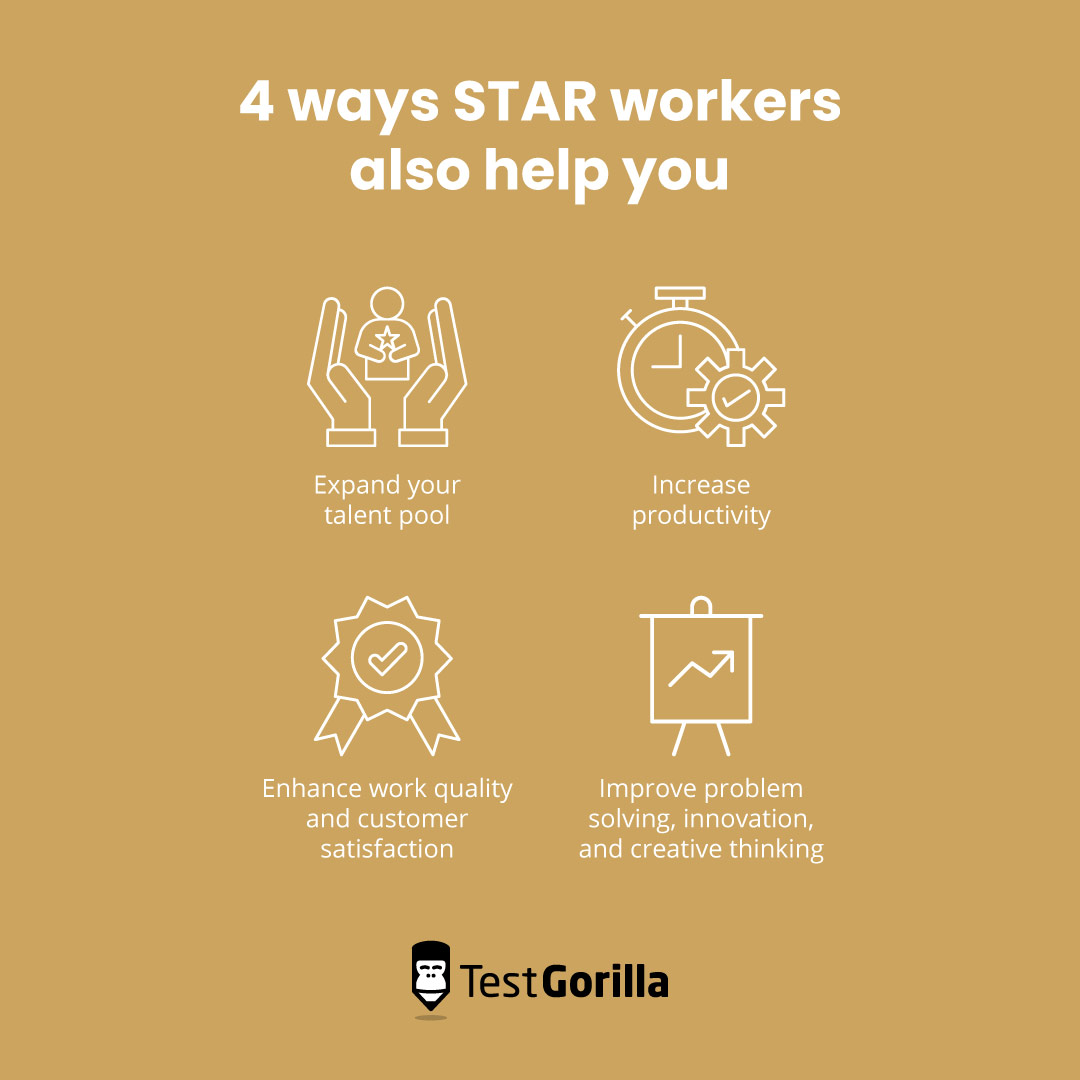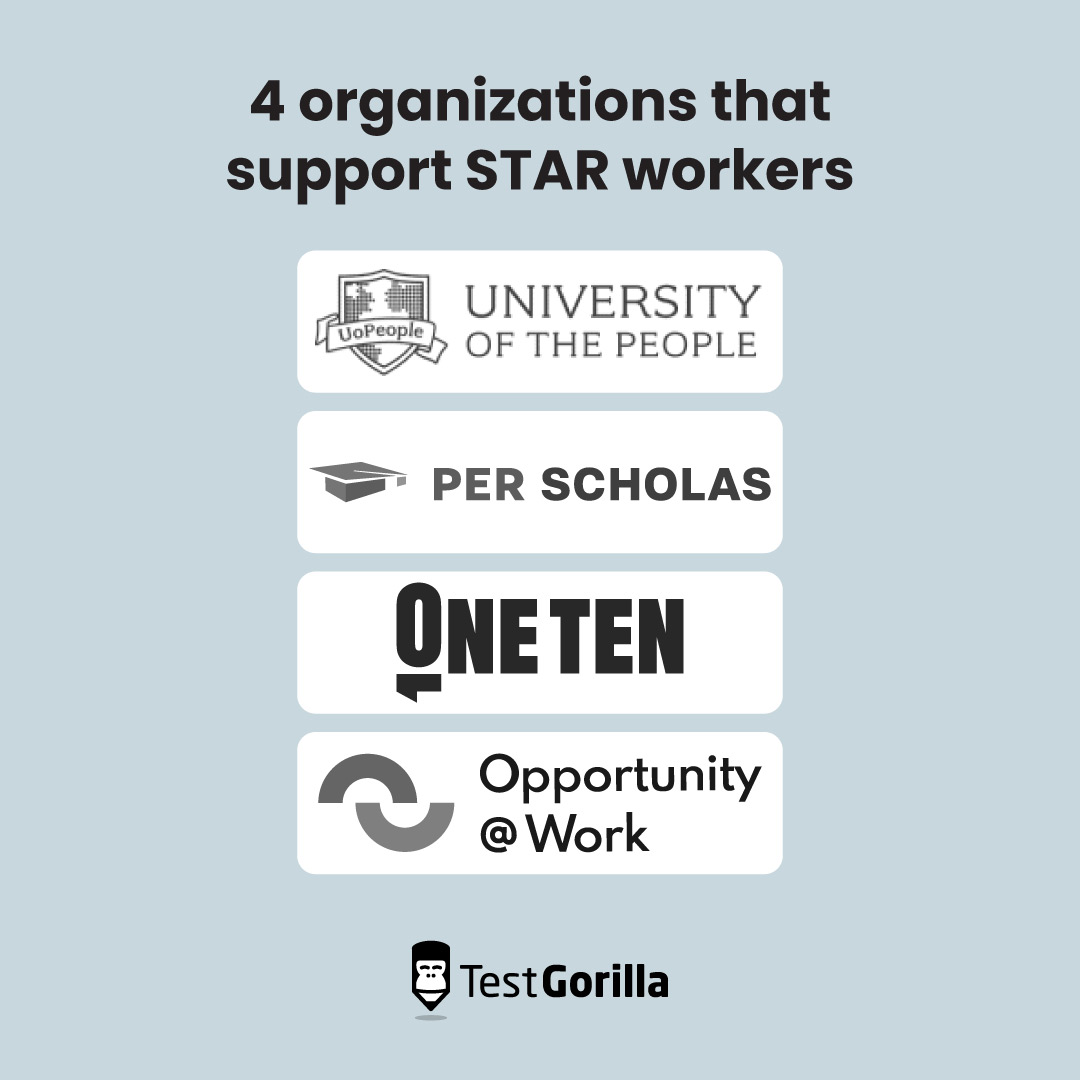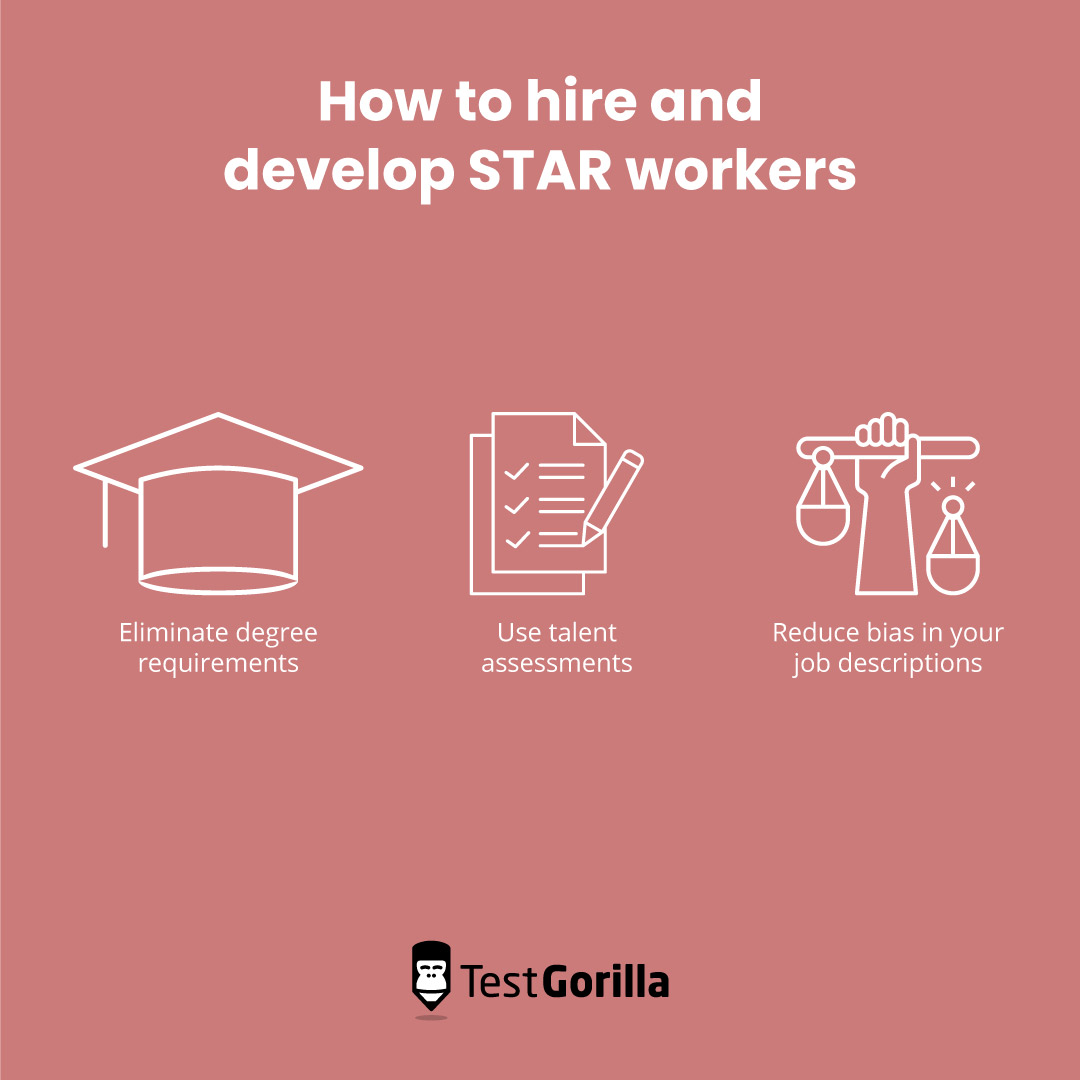What these 4 organizations can teach us about hiring and helping STAR workers
Workers skilled through alternative routes (STARs) account for 50% of the US workforce. However, they’re often overlooked by employers that insist on a mandatory 4-year university degree.[1] By doing so, these employers significantly limit their talent pool and risk missing out on individuals who can thrive at their organization and help it succeed.
However, there are people working to change this.
“As someone who would be considered a STAR worker, and now coaches other STAR workers, I was able to succeed and advance in my early career once I found the right organizations that embraced the unique path I took. If other leaders out there can do the same, they’ll have a loyal team member with the ambition to do great things.” - Braxton Wood, founder of Career on Command
This is why organizations like advocacy and research body Opportunity@work are leading the way and proving that, with the right support, STAR workers can shine.
In this piece, we’ll look at the benefits of hiring and supporting STARs. We’ll also look at four organizations working to get STARs into employment and what they can teach us about hiring this group of workers. Finally, we’ll give you some tips on how you can hire and develop STARs to build a stronger, more diverse workforce.
Who are STAR workers?
STAR workers represent a growing segment of the international workforce that has acquired its skills and expertise through non-traditional pathways.
These individuals often bypass traditional higher education like four-year degrees. Instead, they gain knowledge, skills, and experience through vocational training, apprenticeships, community college, on-the-job training, or online learning platforms.
For example, a STAR worker could be someone who completes a coding boot camp to acquire programming skills and quickly becomes proficient in web development. It could also be someone who undergoes an apprenticeship in a trade, such as plumbing or carpentry, to develop highly sought-after skills.
By embracing alternative routes to skills development, STAR workers showcase the effectiveness of non-traditional educational models. They demonstrate that a person’s potential for success isn’t just determined by formal degrees but by the ability to acquire practical skills and adapt to evolving industry needs.
However, despite their capabilities, many STAR workers encounter what is known as the paper ceiling. This invisible barrier of bias and discrimination keeps individuals without traditional university degrees from accessing jobs they have the skills for.
By relying on traditional hiring methods like resumes and degree requirements, employers often overlook these individuals. Additionally, since people without traditional degrees are more likely to be from underrepresented groups, these organizations will be less diverse and have fewer talented individuals that could help them win the talent war.
This doesn’t have to be the case. Let’s take a look at some ways breaking the paper ceiling benefits your people and organization.
Why hiring STARs benefits everyone
Hiring STAR employees helps you build more diverse, resilient, and adaptable teams. Research also shows companies that purposefully hire these “hidden workers” report being 36% less likely to face talent and skills shortages.
These organizations also find that their STAR workers outperform their peers on six key criteria: attitude and work ethic, productivity, quality of work, engagement, attendance, and innovation.
STAR workers also help you:
Expand your talent pool. An Opportunity@Work report found that the majority of STARs frequently possess the skills needed to transition to a higher-paying job.[2] By not letting them fly under your radar, you can unlock a valuable, untapped talent pool and find the right people for the right roles – whether they have a four-year degree or not.
Improve problem-solving, innovation, and creative thinking. By bringing employees from traditional and non-traditional education backgrounds together, you increase diversity of thought and perspectives. With more ways to approach a problem, your people can collectively make better, more creative decisions.
Enhance work quality and customer satisfaction. When your teams reflect the diversity of your client base, they’re better equipped to communicate with different audiences and provide solutions that come from a place of empathy and cultural competence.
Increase productivity. STARs are self-motivated and proactive, which means they can work independently and effectively without constant supervision or guidance. They can also adapt to changing situations and prioritize their tasks accordingly.
Now you know the benefits of hiring STAR workers, let’s take a look at the organizations trying to help them.
The best insights on HR and recruitment, delivered to your inbox.
Biweekly updates. No spam. Unsubscribe any time.
4 organizations that support STAR workers
The following four pioneering organizations have committed to supporting STARs over the years. Read on to find out how you can do the same.
1. Opportunity@work
Opportunity@Work is a nonprofit advocacy and research organization that aims to advance economic mobility for STARs. It works with employers, educators, policymakers, and other stakeholders to “rewire the labor market” and create more opportunities for STARs to access good jobs that match their skills and potential.
Through its STARs Insights program, it provides data, strategies, and tools to help STARs showcase their talents and connect with employers who value them. Other programs include:
STARsInnovation brings STARs, talent developers, employers, policymakers, and funders to find innovative solutions that address STARs’ needs.
STARsPolicy is a project that aims to shape policies and make systemic improvements that give STARs more equitable access to high-paying jobs.
Stellarsight is Opportunity@Work’s digital strategy dashboard that aggregates “the latest national labor market and STARs data” so employers and organizations can find the best ways to source these individuals.
Stellarworx matches skills-first employers with qualified STARs using a talent-matching platform.
Opportunity@Work teaches us that there’s no one-size-fits-all solution to tearing down the paper ceiling and that organizations need to collaborate to devise a multi-pronged approach. It believes that “changing workplace culture…requires getting to the root causes of implicit and explicit biases in human behavior as well as the unintentional ones embedded in algorithms and standard procedures.”
When you invest in STAR workers, you can improve your talent outcomes, strengthen your diversity and inclusion, and improve business performance.
2. OneTen
OneTen is a nonprofit that aims to “close the opportunity gap” and “hire, promote, and advance one million Black individuals [without] a four-year degree into family-sustaining careers” over the next decade.
By taking a skills-first approach, OneTen helps businesses create inclusive hiring practices that let them access talent in underserved communities and make a long-lasting positive change.
OneTen connects employers with talent partners and leading nonprofits that support the development of diverse and skilled Black workers. It also works with employers like Deloitte and Walmart and talent developers like Code Fellows and Per Scholas to create more pathways for Black Americans to access in-demand jobs and careers.
Finally, OneTen partners with community organizations, like Accenture and the NBA, to provide additional crucial services that supplement those offered by employers and talent developers, such as:
Childcare
Coaching or mentorship
Financial literacy training
Mental health services
Technology, like Wifi and devices
Transportation
OneTen’s efforts teach us that providing “wraparound support,” or holistic, comprehensive care, is the key to success. This means your organization’s hiring efforts should be supplemented by other forms of support like inclusive benefits and learning opportunities.
3. Per Scholas
Per Scholas is a nonprofit organization that provides free training and career development for underrepresented groups in the technology sector. Its aim is to create a more diverse and inclusive workforce by empowering STAR workers to pursue high-paying jobs in tech.
It offers courses in various fields like:
Software engineering
Cybersecurity
Cloud computing
Systems support
Per Scholas also partners with employers to connect graduates with job opportunities as it believes “a thriving workforce starts with equitable access to education.” Eighty percent of its graduates find full-time employment within one year of graduation.[3]
Per Scholas’ mission is to advance economic equity through rigorous training for tech careers and to connect skilled talent to leading businesses. As a result, it’s managed to help 20,000 graduates launch successful careers in tech.
Per Scholas believes that “The right career changes everything”.
“We know that talent is ubiquitous, but opportunity is not. From the digital divide to racial wage gaps to the impact the pandemic has had on women in particular, significant challenges remain in order to achieve an equitable and inclusive workforce. That’s why we’re committed to increasing access and creating opportunities for individuals who aspire to work in tech.”
Per Scholas teaches us that with the right training and development opportunities, there’s nothing STARs can’t accomplish.
4. The University of the People
The University of the People is a nonprofit, tuition-free, American-accredited online university. Its mission is to open access to higher education globally, and help individuals from all backgrounds “overcome financial, geographic, political, and personal constraints keeping them from college studies.”
Founded in 2009 and accredited in 2014, UoPeople collaborates with world-renowned universities like NYU, Harvard Business School, and McGill University to provide Associate’s, Bachelor’s, and Master’s degrees in:
Business administration
Computer science
Health science
IT
Education
UoPeople is staffed by thousands of volunteers, including its founder and president, Shai Reshef, and delivers courses online to groups of around 20-30 students. Through its partnerships, the organization provides opportunities for students to get their foot in the door and demonstrate their skills to some of the world’s leading universities.
According to its data, there are currently more than “126,000 students enrolled from more than 200 countries and territories. Over 16,500 of these students are refugees,” says UoPeople.
“Upon graduation, 92% of those who receive degrees of any kind at UoPeople are employed, including at companies such as Amazon, Apple, Dell, Deloitte, IBM, Microsoft, and JP Morgan, and organizations such as the UN and the World Bank.”
UoPeople demonstrates the value of considering non-traditional educational pathways and recognizing the potential of individuals who may have faced barriers to accessing higher education. It also shows organizations that talent can be found anywhere, within and outside of the traditional education route.
What can we learn from these organizations?
Now that you know more about how these organizations demonstrate their commitment to STARs, here are some ways you can apply those lessons to your own company:
Partner with associations that support STARs like Opportunity@Work to access their resources and network. Through a collaboration like this, you can identify STARs in your industry and region, co-create solutions that address the challenges they face, and spread awareness within your current teams.
Train HR professionals and hiring managers on implicit bias. Give your people what they need to recognize and challenge stereotypes surrounding STARs and tackle conscious or unconscious biases. This way, you can create a fairer, more inclusive hiring and employee development process that values STARs for their potential and performance. Start with interactive workshops, seminars (maybe with guest speakers), and an implicit bias test.
Advocate for STARs and, if possible, work with local governments to influence policies that promote a more inclusive and equitable labor market. You can also encourage the creation of affinity groups in your organization to provide more support to your current STARs. These groups help employees make their voices heard and introduce positive changes to your hiring processes. Almost 45% of STARs don’t feel connected to their coworkers, according to Opportunity@Work data. Advocating for them and helping them feel “a part of the crowd” is a great way to support them.[2]
Provide access to technology to ensure STARs can apply online and complete their work in the same way as those from more privileged backgrounds. For example, you can offer necessary tools like computers, laptops, and a stable internet connection, either by directly providing the equipment or offering stipends for purchasing devices. Consider partnering with technology providers or organizations that focus on ending digital poverty and bridging the digital divide for STARs.
Offer reskilling and upskilling opportunities at your organization to facilitate internal mobility and ensure STARs’ continued success. You can do this through continued development conversations, personalized learning paths, workshops, conferences, and mentoring programs.
How to hire and develop STAR workers
If you’re feeling inspired by these pioneers and their lessons, here are some more actionable tips on how to get started with hiring and developing STAR workers:
Eliminate degree requirements in your job descriptions to expand your talent pool, level the playing field for diverse candidates, and find people with the skills you need. Instead, clearly define the job requirements and necessary skills and look for candidates with equivalent experience. To get started, consider running a skills gap analysis to get a better idea of what you need. You can also consider alternative credentials like specialized certifications or a portfolio.
Use talent assessments to test each candidate’s abilities in an objective, data-backed way and find the best person for the job. For example, if you’re hiring a software engineer, you can test them on their coding skills or algorithm knowledge to help you make unbiased hiring decisions. You can also use talent assessments as part of skills-first onboarding and for ongoing skills development after STARs join your organization.
Reduce bias in your job descriptions and emphasize how you’re tackling that issue throughout the hiring process. Use inclusive language, blind resumes, and structured interviews to make sure everyone is assessed fairly. On both your website and job postings, you can also mention that you’re an equal opportunity employer that values candidates’ skills, not where they obtained them.
Implementing these measures can have a positive impact on your organization. Our 2022 State of Skills-Based Hiring report found that 91.1% of organizations reported an increase in diversity after switching to skills-based hiring. On top of that, 92.5% of employers saw a reduction in mis-hires, 91.4% reduced total time-to-hire, and 89.9% reduced the overall cost-to-hire.
Related posts
STAR workers: A shining light in your organization
Workers skilled through alternative routes (STARs), make up half of the US workforce. Yet they still fly under the radar of companies that rely on outdated hiring practices.
If this is you, you’re limiting your access to qualified, talented individuals who can make your organization shine.
By taking a skills-based approach to recruiting, you can make your organization a fairer place to work for all your employees, regardless of their background. Hiring based on skills, as opposed to university degrees, lets you hire individuals who are the right fit for the role and your teams, which can drive better business outcomes.
In this piece, we reviewed four organizations – Opportunity@Work, OneTen, Per Scholas, and the University of the People – that are blazing a trail and supporting STARs to reach their full potential.
They do this by connecting with governments to shape equitable policies, connecting STARs to employers and mentors, offering tuition-free training and career development courses, and providing services like mental health care.
These companies are actively supporting STAR workers by implementing initiatives targeted at attracting, training, and connecting individuals from diverse backgrounds to higher-paying opportunities. By studying their successes and learning from their experiences, you can gain valuable insights into how to support and empower STAR workers within your own organization, fostering an inclusive and equitable environment for all.
Additionally, by adopting skills-based hiring and retention practices, you can level the playing field for STARs and help them reach for the same opportunities as those who’ve followed traditional education paths.
Want to see the tangible benefits of looking to the STARs? Start your journey with skills-based hiring for free with TestGorilla.
Sources
“A (work)force to be reckoned with.” Tear the Paper Ceiling. Accessed July 13, 2023. About STARs (tearthepaperceiling.org)
“Rise with the STARs.” Opportunity@Work. Accessed July 19, 2023. Rise with the STARs: Building a Stronger Labor market for STARs, Communities, and Employers - Opportunity@Work (opportunityatwork.org)
“About Per Scholas.” Per Scholas. Accessed July 13, 2023. About Per Scholas - Mission: Tuition-free IT Training
“About Per Scholas.” Per Scholas. Accessed July 13, 2023. About Per Scholas - Mission: Tuition-free IT Training
Thanks to Braxton Wood, founder of Career on Command, for insights.
You've scrolled this far
Why not try TestGorilla for free, and see what happens when you put skills first.





















